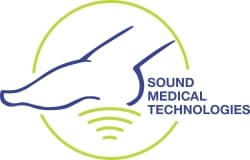Laser Wart Providers… Find a Doctor to treat plantars warts with laser in PA
Laser Warts Treatment Near Me !
An Overview
Find a Dr. to treat plantars warts with laser in PA Do your warts in your shoes because they are so thick? Do you hide your feet in the sand at the beach, or wear your hot shoes in the summer? Are you interested in a simple easy way to get rid of the warts that isn’t painful? Safe affordable treatment of plantars warts that really works! Sound Medical Technology has the latest laser technology available and we bring it to you!
We can treat plantar warts, fungus toenails, chronic muscle and joint pain and more. We are about OPTIONS! Especially for difficult to treat conditions like plantar fasciitis, plantar warts, and toenail fungus. We have options to fit your health considerations and also every budget! And we offer these choices and alternative treatments through Board Certified local Podiatrists. Call for the podiatrist in your area with this technology! 724-991-0116 Sound Medical Technology.
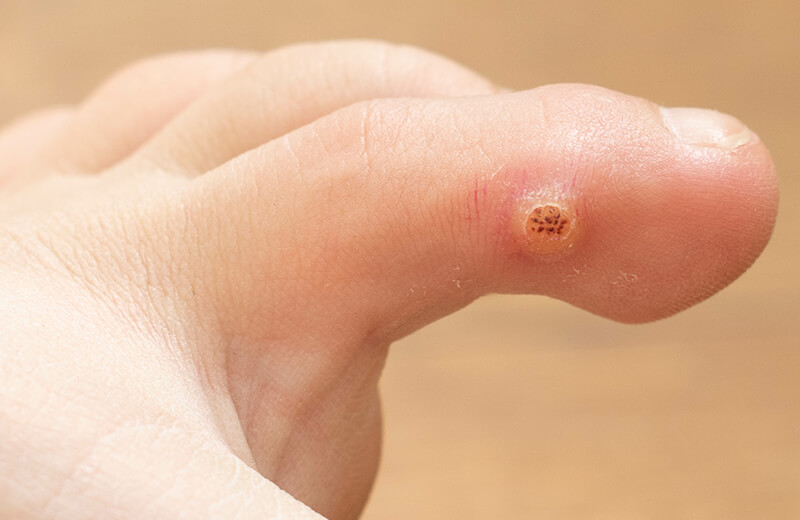
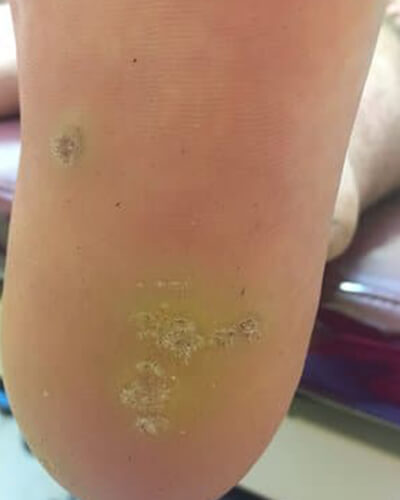
Before Treatment
This patient presented after 2 years of treatments for plantar warts at another local podiatrist.
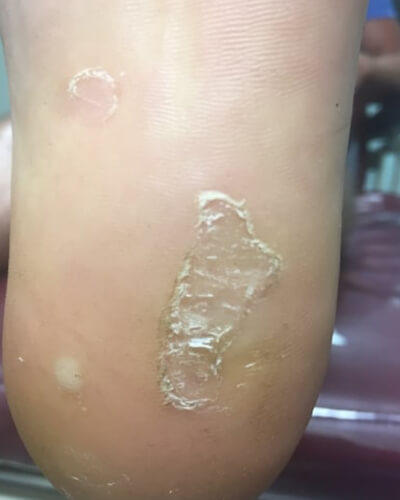
During Treatment
By the third treatment the warts on the foot were already disappearing. The patient was amazed, after suffering for so long.
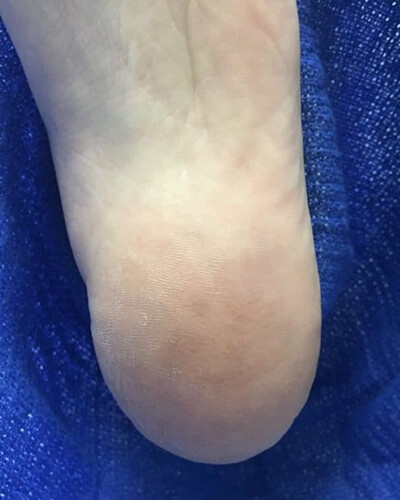
After Treatment
This is our patient on visit 4. A final laser treatment was administered to ensure all warty tissue was killed.
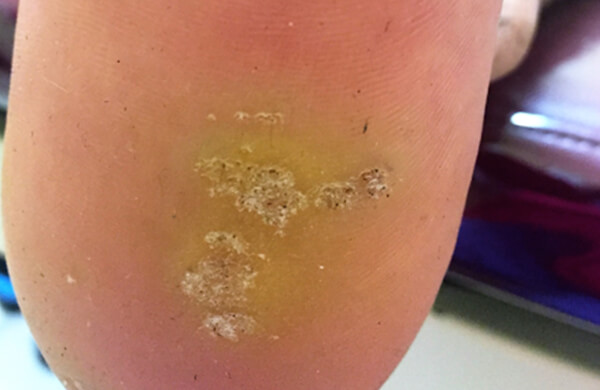
Who is More Likely to Develop Plantar Warts?
Individuals with compromised immune systems are more likely to develop plantar warts. People living with HIV/AIDS, taking corticosteroid medication, or suffering from pneumonia are more likely to develop plantar warts. Epidemics of plantar warts often show up in environments that people share equipment, such as locker rooms.
Children have the highest risk of developing plantar warts because their immune system has not had the experience of fighting this off before. Fortunately, these warts heal fast when developed on children.
If you are feeling discomfort or pain in your step or noticing strange patches of yellow skin on your feet, then it may be time to get checked for plantar warts. These warts are very common because the feet constantly touch the ground, which increase the chances of picking up HPV. There are many types of HPV, and several can cause plantar warts to appear.
How Do I Know if I Have Plantar Warts?
The first symptom to look out for is the feeling of “painful pebbles” when walking in shoes. When the wart is compressed, you may experience pain on the side that is affected. Sometimes plantar warts can be mistaken for calluses, but it is important to identify a circular flat spot with a depressed area in the middle. Plantar warts may have a yellowish crust and small black dots that can easily distinguish it as a plantar wart. You may experience one or all of the symptoms listed, most of which are visual.
Keep a close eye on your feet if you suspect that plantar warts are present. Check with your healthcare provider if you think you have a case of the plantar warts.
Can I go home after treatment?
In most cases, you can go home immediately after laser wart treatment. It is generally an outpatient procedure that does not require hospitalization or a prolonged recovery period. However, it’s important to follow any post-treatment instructions provided by your healthcare professional for optimal healing and results.
Are there any medications or products I should avoid before or after the treatment?
Before undergoing laser wart treatment, it’s important to follow your healthcare professional’s instructions regarding medications and products to avoid. While specific recommendations may vary based on individual circumstances and the type of laser used, here are some general guidelines:
- Photosensitizing medications: Certain medications can increase your skin’s sensitivity to light and may interfere with the effectiveness of laser treatment. Examples include some antibiotics, antifungal medications, and certain acne medications. Inform your healthcare professional about all the medications you are taking to determine if any adjustments are necessary.
- Topical products: Avoid applying any creams, ointments, or lotions to the area being treated on the day of the procedure. These products can interfere with the laser’s effectiveness or cause unwanted reactions. Follow your healthcare professional’s instructions regarding the use of topical products before and after the treatment.
- Retinoids: If you are using topical retinoids, such as tretinoin or adapalene, discuss with your healthcare professional whether you should temporarily discontinue them before the laser wart treatment. Retinoids can increase skin sensitivity and may need to be avoided to minimize the risk of adverse reactions.
- Sun exposure: Avoid excessive sun exposure and tanning beds in the days leading up to the treatment. Sunburned or tanned skin can be more susceptible to complications during laser treatment. Use sunscreen and protective clothing if you need to be outdoors.
- Makeup and cosmetics: If the warts are on an area where you typically apply makeup or cosmetics, your healthcare professional may advise you to remove them before the treatment.
What Does “Plantar” Mean?
Plantar refers to “of the sole” in Latin form. Plantar warts are different in that they are quite painful due to the pressure of walking and standing. Like most warts, plantar warts are caused by HPV. The wart can have finger-like roots that reach down to grow, which makes it tougher to treat from the surface of the skin.
FAQ’s for Laser Treatment of Plantar Warts!
How many Treatments do I need to treat my plantars wart?
One treatment should be enough for new tiny warts, but if you’ve let them grow for a while and they’ve started spreading it may take 3-5 or even 12 if they are very large, however, depending on the condition of your immunity usually it takes three or four.
How long does a laser wart treatment take?
In less than 5 minutes Sound Medical Technologies and your local podiatrist can treat your wart! It is painless and effective.
Do warts come back after laser treatment?
The wart that is present can be killed. However, some people are prone to reinfection as they are predisposed from injury, running, genetics, hyperhidrosis or other factors. That is why either periodic reassessment improves the effectiveness of the treatment.
What is the Cost of Laser wart treatments?
call Rich at 724.991.0116 or email us to find out the cost of laser toenail fungus procedure in New Jersey or Pennsylvania. It is usually covered by insurance.
Is Laser treatment of warts in Pennsylvania right for me?
There are few people that this may not work well for, such as patients with poor circulation or other immune compromised patients. Safety wise, laser wart treatment is safe for anyone, however we do not perform laser treatments on pregnant women and diabetics with neuropathy should take extra precautions. This is why we partner with YOUR trusted physician that knows your medical history and is familiar with your feet. If your Podiatrist can not accommodate you, we will find a Board Certified Podiatrist near you.
How Does Skin Heal After A Wart Laser Treatment?
The recovery from wart laser treatment is usually divided into few stages, here’s the brief info:
- Initial Healing: First stage of the treatment involves a red, swollen and slightly sore treated area. Also, it’s possible for a scab or a small blister to form, from where the wart was removed.
- Scab Formation: Gradually the skin will begin to heal, and a scab will. Start developing on the treated area to protect the underlying tissue. You will see this in the first few days!
- Scab Falls Off: After 1-2 weeks, the scab will fall off on its own, just like it does after every injury. This will reveal a new pink skin underneath. Make sure you do not scratch or try to remove the scab on your own as it can increase the chances of infection.
- Skin Regeneration: Soon after that, your new skin will start blending with rest of the skin which will make the treated area much less noticeable.
- Final healing: Final healing is just a period where the treated area completely blends into the skin. It may remain discolored for a while, but it will be fine really soon.
Will The Wart Come Back?
Although Laser treatment is really effective, there are still some chances of return of the wart, especially due to lack of care. Here’s how it can happen:
- Incomplete destruction: If the laser does not destroy the wart completely or its root then the wart may reoccur.
- Immune System: An individual’s immune system plays a big role in healing, however if it’s not strong enough to fight back, the chances of wart returning increases.
Can Children Get Wart Removal?
Yes, it’s a safe procedure for children but it can be painful and uncomfortable, so an anesthesia may be used.
How does Laser treatment of warts work?
Without hurting or damaging your regular skin, the specific wavelength of light targets the chromatophores (pigments in the blood) in the capillaries feeding the warty tumor, coagulating them, much like you cook an egg. The laser light photons penetrate the skin, the cells of the fungal blood vessels (black dots you can see when you look at the wart) absorb this energy and it is converted into energy which does the work only in the targeted wavelength containing tissue. The wart lives in the space mostly under the skin, which makes it difficult for topicals to penetrate. Once the laser penetrates to the space under the skin, it kills the targeted wart, allowing the skin to grow out wart -and thus damage- free! To find your closest provider of laser wart in Pennsylvania, call 724-991-0116, or email us.
Are there side effects to using Lasers to treat warts?
Sound Medical Technologies uses Laser Therapy for the treatment of verruca. This technology has been used around the world on a wide scale over many years.It has been proven to be very safe and very effective for millions of patients.
Will the laser toenail treatment hurt?
You may experience a warm feeling, however no pain is involved during the laser nail treatment in Bethel Park.
Can’t I just use topical antifungal medicines to treat my nail fungus?
Topical antifungals to treat nail fungus in you Podiatrist office in Pittsburgh work well with an accurate diagnosis and consistent daily application over the course of at least a year. However, over the counter medication from drugstores have a high fail rate for many reasons.
What is the laser wart treatments in State College like?
The handpiece is held about 1 cm from the nail and short pulses 1/20 of a second in length send energy through the nail plate and into the nail bed where the fungus lives. All of the nails on an affected foot should be treated since they share a shoe and can be infected without your knowledge, a thorough exam by your podiatrist will help ensure an accurate diagnosis. The treatment is not painful and you may get a not unpleasant warm feeling.
How many Laser treatments do I need to clear up my warts?
For mild foot warts in Harrisburg, often only one laser treatment is all it takes to annihilate the tiny ones and start the process of the skin growing out wart free over the next few weeks If your nails have been previously damaged or are completely mycotic (filled with fungus) then a series of 3-4 treatments may be necessary over several months as the nails grow, which is at a rate of about 1mm a month. The fungus is technically killed immediately, however the changes won’t appear until a new nail has replaced the old. Your Podiatrist will continue to debride (thin out and sand down) the nail to allow better laser penetration and improve the appearance of the nail immediately. An occasional follow up treatment may be necessary over time if you have conditions that make you prone toward fungus.
How long will the a treatment take?
Laser verruca treatments in Washington, D.C. typically takes between 5-10 minutes, depending on the severity of the wart.
When can I resume normal activity after having laser wart treatment?
Immediately! There is no down-time following laser wart treatments in New York, so you may resume normal activities as soon as you leave.
Is Laser Wart Treatment a Painful Procedure?
Fortunately, laser wart treatments aren’t considered painful but they can cause some mild discomfort. Patients who have underwent this treatment often describe the sensations as similar to rubber band snapping against the skin or a sharp, brief pinch.
Also, the level of discomfort can depend on several factors, which can include:
1. Location Of The Wart: Some sensitive areas like feet, and fingers may feel more discomfort compared to others.
2. Size and Depth Of The Wart: Larger and deeper require more intense treatment, which can be painful.
3. Individual Pain Tolerance: Not every patient have the same pain tolerance, which is why this factor varies greatly among patients.
However, if you are afraid of pain then do not worry, since doctors can always use local anesthesia to minimize the discomfort. You can experience some soreness, redness, or swelling after the treatment, but it will also subside within few days.
Is It Possible To Use Laser Treatment for Warts on Sensitive Areas Like Face or Genitals?
Yes, fortunately it’s possible to use laser treatment for warts in sensitive areas like the face, or genitals but it requires some careful consideration. Thanks to precision and effectiveness at targeting the wart, laser treatment is suitable for such delicate areas and you don’t even need to worry about significant damage to the surrounding skin. Here are some key points to consider:
1. Pain Management: Local anesthesia will be used during treatment, because as mentioned earlier, the pain will be mild but can vary depending on patient’s tolerance levels.
2. Effectiveness: Laser treatment is most effective on warts that are stubborn, and can’t be removed with other treatments like cryotherapy, or topical solutions.
3. Post-treatment Care: Treated area is prone to swelling and redness or even irritation, that’s why proper care and follow-ups are essential.
What advantages does Laser treatment of warts have over other forms of treatment?
Laser treatment of warts in Ohio offers several advantages over other forms of treatments. These advantages include:
- No surgery! wart laser treatment for verruca is a completely non-invasive procedure.
- No side effects! Other than watching your wart slowly die and your skin slowly resume its normal appearance, laser treatment for warts has no known risks or adverse reactions. Other treatment options, such as oral medication, can be detrimental.
- No downtime! Once your treatment is complete, you are free to go about your day as usual with no worries of post-treatment pain.
What happens during wart treatment with laser?
Laser treatment of toenail fungus in Ohio offers several advantages over other forms of treatments. These advantages include:
- No surgery! Toenail laser treatment for fungus is a completely non-invasive procedure.
- No side effects! Other than watching your toenails slowly resume their normal appearance, toenail laser treatment for fungus has no known risks or adverse reactions. Other treatment options, such as oral antifungals, can be detrimental to your liver.
- No downtime! Once your treatment is complete, you are free to go about your day as usual with no worries of post-treatment pain.
What happens during nail treatment with laser?
During the laser treatment for plantars warts in West Virginia, your verruca will first be shaved down by your podiatrist. This is done to reduce the thickness of the wart in order for the laser to penetrate more deeply. The laser technician will treat each wart individually. During the treatment, you should not feel pain, but may feel a warming sensation that some have described as a light rubber band snap. The treatment itself should take no longer than 5-10 minutes. Once the treatment is complete, you should not have any discomfort and may resume normal activities.
When will I see improvement?
It is important for patients to remember that your wart will not look different following laser treatment for warts in Maryland right away after treatment, then you will slowly see improvement.
How To Prevent Warts In The Future?
If you properly follow some preventive tips then being protected from warts isn’t a big deal, here are some of the most useful preventive tips for warts.
- Never Go Anywhere Barefoot
Wart causing bacteria can be anywhere especially in places with moisture, these moisture reach places can include gyms, public showers and swimming pools.
If you stay barefoot in these areas then you will get infected by wart-causing bacteria so never forget to wear slippers or sandals in such places.
- Keep Your Hands And Feet Clean
Warts are contagious which means you can receive them from other people, if you shake your hand with them then you will receive their germs that will cause you warts.
Therefore after coming back home always wash your hands and feet properly, even if you don’t interact with people suffering from warts.
If your family member is suffering from warts then do not share anything with them, use separate clothes, nail clippers, towels and avoid direct contact.
If possible then ask them to wear socks for protection of your family.
- Avoid Biting Your Nails
Biting your nails may not seem dangerous but it’s more harmful than you think. When you bite your nails the skin around your nails is damaged.
This can increase the risks of wart causing bacteria entering your body, which can cause you serious infections too!
What Happens If Wart Is Left Untreated?
When you leave this problem untreated then you will have to deal without many kind of serious infections, which can be harmful to your health.
Furthermore, leaving it untreated will affect your family too, you may infect your family members and people around you too.
Lastly, if you try to get the treatment after developing serious complications then it may be hard for you to treat the wart later.
Can laser treatment be used for both common warts and plantar warts?
Yes, laser treatment can be used for both common warts and plantar warts. Laser therapy is a medical procedure that utilizes focused light to target and remove abnormal or unwanted tissue, including warts. The laser’s energy is directed at the wart, leading to the destruction of the blood vessels that supply it and causing the wart tissue to break down.
Whether laser treatment is the most suitable option depends on various factors, including the type, size, and location of the wart, as well as individual health considerations.
Can laser treatment be used for facial warts?
Yes, laser treatment can be used for facial warts. Laser therapy is a versatile approach for wart removal, and it is commonly employed to address various types of warts, including those on the face. The focused light energy from the laser is directed at the wart, leading to the breakdown of blood vessels that supply the wart tissue. This causes the wart to be removed.
How does laser therapy target the virus causing warts?
Laser therapy primarily targets the blood vessels that supply the wart rather than directly attacking the virus causing the wart. Here’s how laser therapy works in the context of wart removal:
- Absorption of Laser Energy: The laser emits a specific wavelength of light that is absorbed by the hemoglobin in the blood vessels feeding the wart.
- Heat Generation: As the laser energy is absorbed, it generates heat. The heat is then transferred to the blood vessels, causing coagulation and sealing them off.
- Deprivation of Blood Supply: By coagulating the blood vessels, laser therapy cuts off the blood supply to the wart. This deprives the wart of essential nutrients and oxygen.
- Wart Tissue Breakdown: Without a blood supply, the cells in the wart begin to break down. Eventually, the wart tissue dies, and the body’s natural processes eliminate the dead tissue.
Does insurance pay for Laser wart treatments?
Laser wart treatment for verruca in Pennsylvania is currently covered most insurances, as it is considered a medical procedure. Call 724-991-0116 for pricing and a provider near you.
Why choose Sound Medical to treat my laser wart syndrome?
If you want a quick effective treatment for plantar warts with laser we can bring it to you via your local podiatrist with our mobile unit or match you with a local participating Podiatrists in Pennsylvania! Call Sound Medical Technologies to learn how you can have this technology available on a case-by-case basis, without purchase or lease. We deliver and set up the machine and provide you with educational materials for patients. You provide the procedure. You maintain control of the patient relationship. You receive the reimbursement into your practice.
What should I do if the wart returns after laser treatment?
If the wart returns after laser treatment, consider taking the following steps:
- Consult Your Doctor: Schedule an appointment with your healthcare provider to discuss the recurrence and evaluate your options.
- Follow-Up Treatments: Your doctor may recommend additional laser sessions or alternative treatments to completely remove the wart.
- Alternative Therapies: Consider other treatments like cryotherapy, topical medications, or surgical removal if laser treatment isn’t effective.
- Boost Immune System: Strengthen your immune system through a healthy diet, regular exercise, adequate sleep, and stress management, as a strong immune system can help fight off warts.
Can laser treatment cause scarring?
Yes, laser treatment can cause scarring, although it is relatively uncommon. The risk of scarring depends on several factors, including the type of laser used, the size and depth of the wart, the skill of the practitioner, and your skin type and healing ability. Here are some details:
Factors Influencing Scarring Risk:
1. Type of Laser:
– Some lasers are more precise and less likely to cause scarring. Discuss the type of laser with your doctor.
2. Practitioner Skill:
– An experienced and skilled practitioner can minimize the risk of scarring.
3. Skin Type:
– Certain skin types are more prone to scarring. Darker skin tones may have a higher risk of hyperpigmentation or keloid formation.
4. Post-Treatment Care:
– Proper care after the procedure, such as keeping the area clean and avoiding sun exposure, can help reduce the risk of scarring.
Minimizing Scarring Risk:
1. Choose an Experienced Practitioner:
– Ensure your treatment is performed by a qualified and experienced healthcare provider.
2. Follow Post-Treatment Instructions:
– Adhere to all post-treatment care instructions provided by your doctor.
3. Avoid Sun Exposure:
– Protect the treated area from sun exposure to prevent pigmentation changes.
Laser
The CO2 laser was one of the first lasers clinicians used on plantar verrucae. It is an ablative laser in the infrared spectrum with a beam that performs as a scalpel. The beam targets water and is non-selective in its tissue destruction. The area must heal by secondary intention.
Clinicians should discuss the possibility of scarring, delayed healing, and post-procedure pain. Clinicians should wear a mask, have a smoke evacuator and be cautious due to the plume that the laser creates. There have been zero randomized controlled studies with the CO2 laser as monotherapy for plantar verrucae. Although, when combined with topical therapies like imiquimod 5% cream have shown moderate success.
The neodymium yttrium garnet (Nd:YAG) is also in the infrared range. This is a non-ablative laser which targets the oxyhemoglobin which allows for selective heating of the capillary rich verrucae.
46 patients with plantar warts were treated with either Nd:YAG laser or a pulsed dye laser. There was no significant difference in the use of the two lasers with a clearance rate of 73.9 percent for the pulsed dye laser and 78.3 percent for the Nd:YAG laser group. The Nd:YAG laser treatment was more painful compared to the pulsed dye laser which required more treatments. In conclusion, both lasers produce less downtime and possible scarring than CO2 devices.
